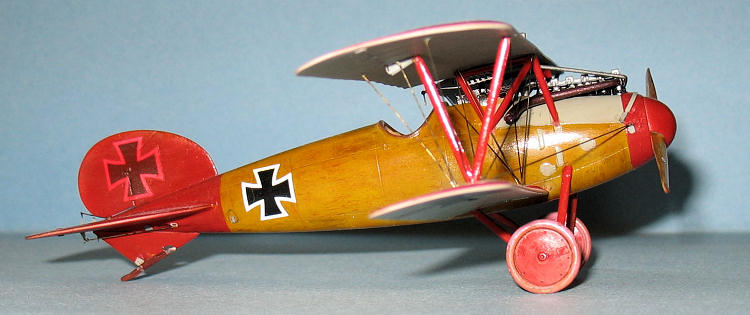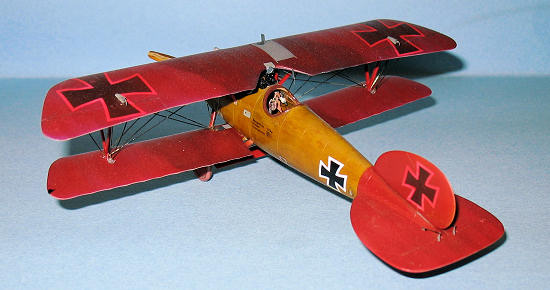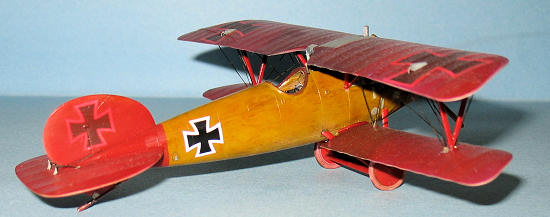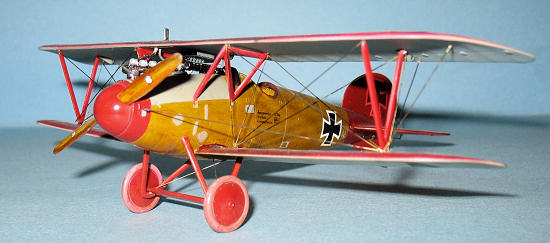
Eduard 1/48 Der Rote Flieger Dual Combo Kit
| KIT #: | 1136 |
| PRICE: | $74.95 |
| DECALS: | Ten options |
| REVIEWER: | Dan Lee |
| NOTES: | Dual Combo Kit which includes various extras but only the Albatros is reviewed as Dr1 died due to clumsiness |

| HISTORY |
The Man
Manfred Von Richthofen
was born into a Prussian aristocratic family located in
Cavalry proved to be
useless against the machine gun so the Uhlans were converted to infantry.
Manfred found this unsatisfactory and soon wanted a transfer to flight
school where he learned to be an observer. This
also proved unsatisfactory even though he apparently shot a plane down with his
machine gun.
 By March
1916, he became a pilot flying two seat observation aircraft.
In August 1916, Manfred met the Oswald Boelcke, the man who made the air
to air combat tactics that are still in use today.
Manfred impressed Boelcke enough to be picked by him to become part of
Jasta 2. By then the Albatros
scouts were starting to replace the obsolete Fokker Eindeckers in front line
units.
By March
1916, he became a pilot flying two seat observation aircraft.
In August 1916, Manfred met the Oswald Boelcke, the man who made the air
to air combat tactics that are still in use today.
Manfred impressed Boelcke enough to be picked by him to become part of
Jasta 2. By then the Albatros
scouts were starting to replace the obsolete Fokker Eindeckers in front line
units.
Soon Manfred started
racking up kills (including then top British Ace Lanoe Hawker) and by January
1917, he earned the Blue Max and was given command of Jasta 11 (soon to be known
as the Flying Circus.) His most productive time was in the Spring of 1917 (aka
Bloody April to the RFC) when he and his unit became the most feared on the
Western Front. He became well known
at the time for his all red Albatros DIII (the type he flew the most and got the
most kills in.)
Manfred was shot down
in April 21 1918 by Snoopy, well, more than likely an Aussie Ack Ack unit while
flying one of his famous Fokker Dr1s.
The Plane
The Albatros DV was the least favorite of the Albatros Series due to poor performance and weaker wings. Even the Red Baron detested the plane as he preferred to fly the older DIII. Unfortunately, it arrived around the same time as the superior SE5a and Sopwith Camel leaving the German Air Arm little to no choice but to use it till better aircraft like the Fokker DVII came along.
| THE KIT |
 This Albatros
is from the Eduard Dual Combo Kit, Der Rote Flieger (the Red Baron) titled after
a German move about the Red Baron and part of the movie cross promotion.
The kit also comes with a Dr1 Triplane kit as well as a Blue Max Replica
and resin figures of the Manfred and Lothar Von Richthofen.
The kit comes with PE, masks and many decal options for both the Albatros
and Dr 1.
This Albatros
is from the Eduard Dual Combo Kit, Der Rote Flieger (the Red Baron) titled after
a German move about the Red Baron and part of the movie cross promotion.
The kit also comes with a Dr1 Triplane kit as well as a Blue Max Replica
and resin figures of the Manfred and Lothar Von Richthofen.
The kit comes with PE, masks and many decal options for both the Albatros
and Dr 1.
The kit parts are very
clean with some flash on the trailing edge of the wings and finely detailed.
For a more detailed
preview of the Dr.1 kit and the Albatros DV, please follow these links.
http://modelingmadness.com/reviews/w1/previews/8161.htm
http://modelingmadness.com/reviews/w1/cleaveralbd5preview.htm
I wish I could have shown the Dr.1, but I had a mishap with the model just as I completed it. I knocked on the floor and the upper wing assembly snapped off and the landing gear shattered to my dismay. I nearly stomped it in rage, but my sanity returned and it is boxed up till I can have a chance to repair it.
| CONSTRUCTION |
It all began with the
cockpit. Various interior parts
which were painted with  Sienna was
dry brushed on to produce the wood effect.
When that was dry, several thin coats of Gunze Clear Yellow were
airbrushed in to give it the lacquered wood look.
Several parts were hand painted RLM02 and Sliver as per instructions.
Sienna was
dry brushed on to produce the wood effect.
When that was dry, several thin coats of Gunze Clear Yellow were
airbrushed in to give it the lacquered wood look.
Several parts were hand painted RLM02 and Sliver as per instructions.
Once it was all dry,
the PE parts were added to the interior including the seat belts which were the
most painful part of the assembly.
The engine was painted
using various metallic shades and installed.
The instructions say you should paint the interior of the engine
compartment the same as the cockpit.
I passed because it was a waste of time and that there is really nothing
to see.
The fuselage bits were
glued together and then the seams were filled and sanded.
The wing and tail parts were cleaned up but not assembled as I had a lot of painting to do.
| COLORS & MARKINGS |
 The
markings I chose were the Albatros DV that the Baron flew for his 57th to 60th
kills. It is red, but it was not
totally red as it had a lacquered wood exterior throughout much of the plane.
This wood effect was accomplished using the same techniques used in the
interior. One thing I do recommend
is using an old thin brush to dry brush the burnt sienna on and not a good one.
Why? Well, I wrecked a very
good sable brush to do this camo and really regretted it as it was my favorite
brush. I varied each panel
individually and even used dark brown in small areas to show changes in wood
tone. It didn’t work as well I
thought it would.
The
markings I chose were the Albatros DV that the Baron flew for his 57th to 60th
kills. It is red, but it was not
totally red as it had a lacquered wood exterior throughout much of the plane.
This wood effect was accomplished using the same techniques used in the
interior. One thing I do recommend
is using an old thin brush to dry brush the burnt sienna on and not a good one.
Why? Well, I wrecked a very
good sable brush to do this camo and really regretted it as it was my favorite
brush. I varied each panel
individually and even used dark brown in small areas to show changes in wood
tone. It didn’t work as well I
thought it would.
Once dry
the wood areas were masked off and the red (with a white base coat) and
RLM02 areas were painted on.
The wings and landing
gear were painted first before assembly while the wheels were masked off for the
various colors (red and pink.) I
painted the upper wing with the original Purple and Green camo, clear coated
then decaled the iron crosses on before I painted it red as per the color guide.
I thought this made it more “real” as apparently the
underneath camo and markings were showed through the layer of red.
I did weather the undersides and tires a bit, but not as much as top aces planes were kept fairly clean by attentive ground crew.
| FINAL CONSTRUCTION |
The machine guns were
modified with Eduard PE (using CA glue), painted and glued in.
I have to admit the PE really does make the
The wings, struts and
landing gear were glued in place. I
didn’t have as hard a time with alignment because I had built the Eduard
Albatros DV before, but it still is fiddly and I recommend a lot of patience as
you assemble. Even a simple jig to
align the wings and landing gear would be welcome.
 The final
tiny bits were painted and glued in place before I got to the worst part of the
build, the rigging.
The final
tiny bits were painted and glued in place before I got to the worst part of the
build, the rigging.
When I built this
model, I had never rigged a biplane ever.
I wanted to rig by SE5a and first DV, but I was too lazy and a chicken
when it came to rigging. This time,
I figured that I would rig the plane.
Instead of going to the old drill, rig and fill method using fishing
line, I would go with a much simpler approach as it did not go will for me when
I made a 1/72 Airfix Pup to test out the technique.
I opted for the more forgiving approached used by Tom Cleaver involving
compass dividers to measure the length of brass wire and then glue it in place
using CA glue and/or Elmers White.
It took a while to rig
the entire plane as there are some 50+ lines that need to be added, but when it
is done it makes the biplane model look good.
If I had to rate the
complexity of the rigging among the various WW1 aircraft then I would rate the
French the easiest, the British and their double (damned) rigging the hardest
with the Germans in between.
The last thing I did
was glue on the wheels. I put the
plane on its back till the glue dried enough for the plane to stand on its own
without causing the wheels to droop.
| CONCLUSIONS |
The Eduard Albatros DV series of kits are excellent kits of a not so excellent plane. I found it to be an enjoyable if fiddly build and recommend them to anyone who wants to build their first 1/48 WW1 biplane. The Red Baron markings make it more interesting and will get noticed by non modelers.
July 2010
If you would like your product reviewed fairly and quickly , please contact me or see other details in the Note to Contributors.